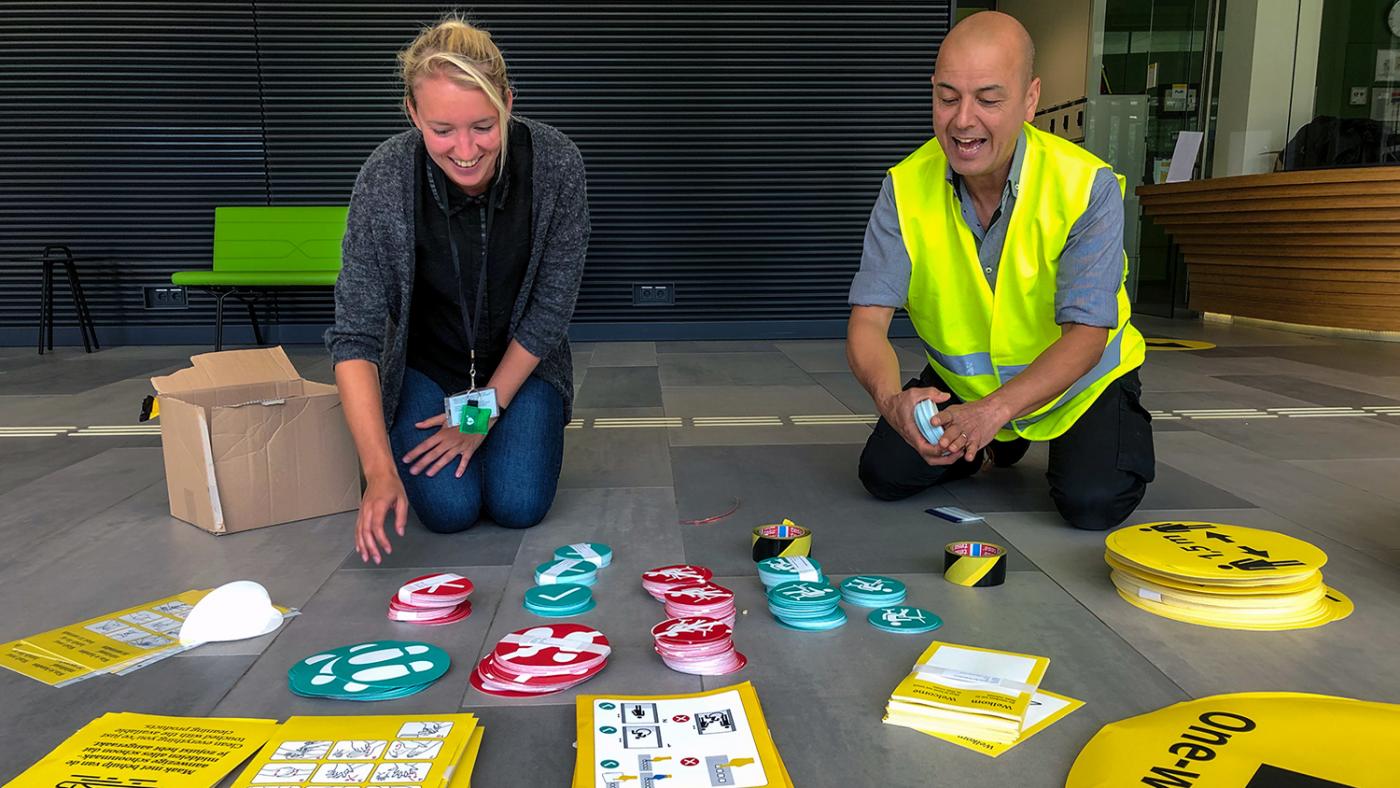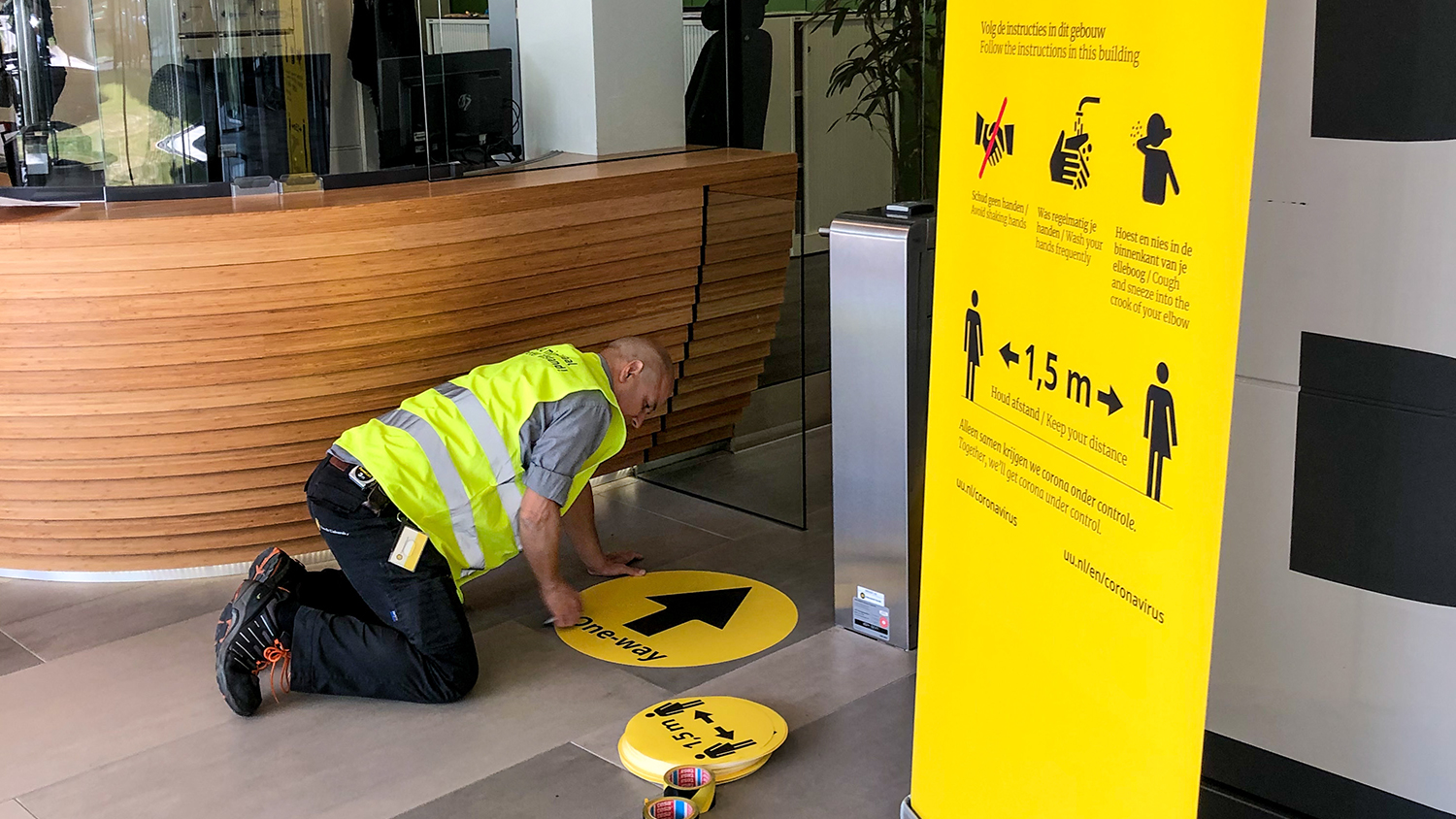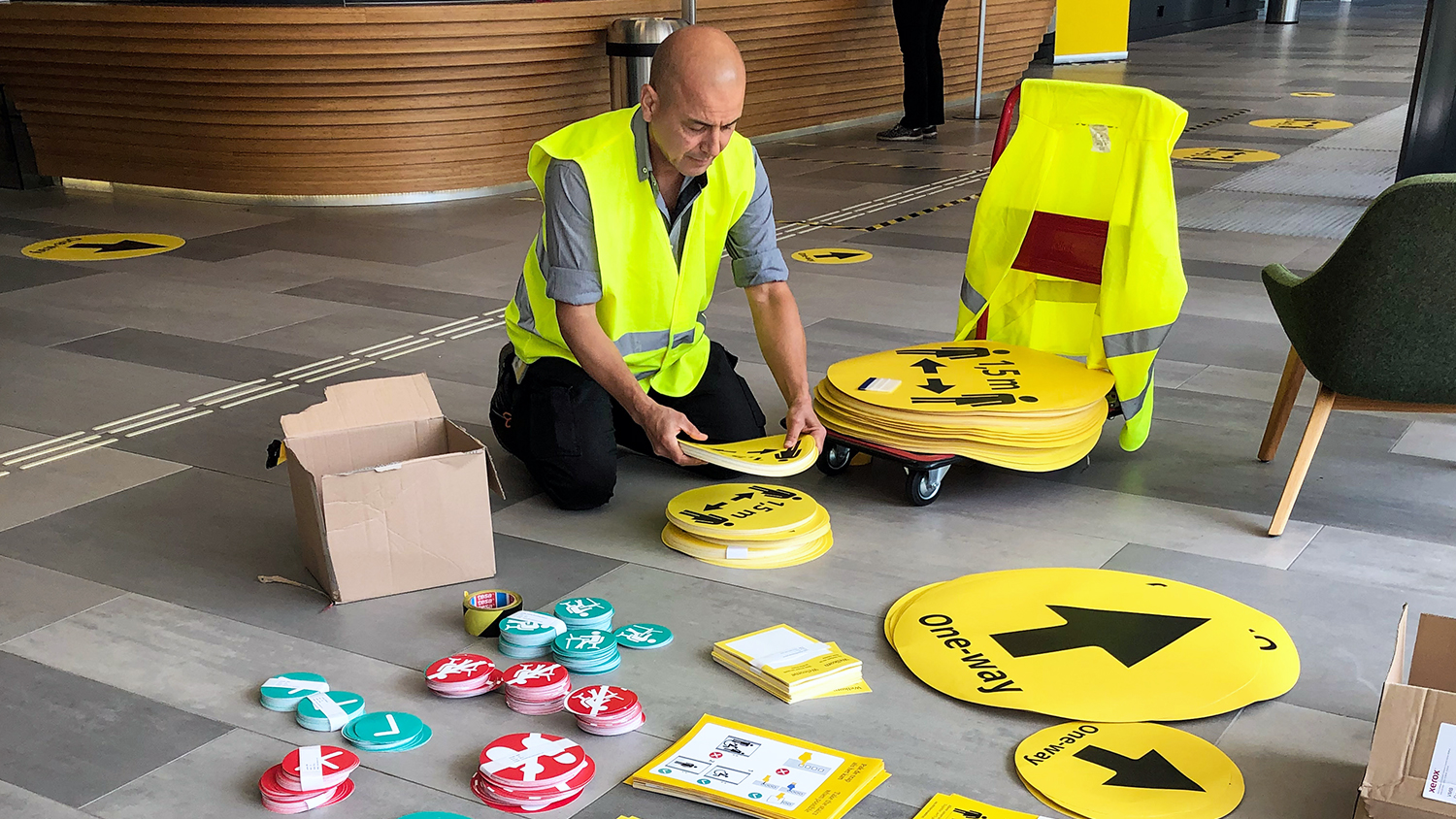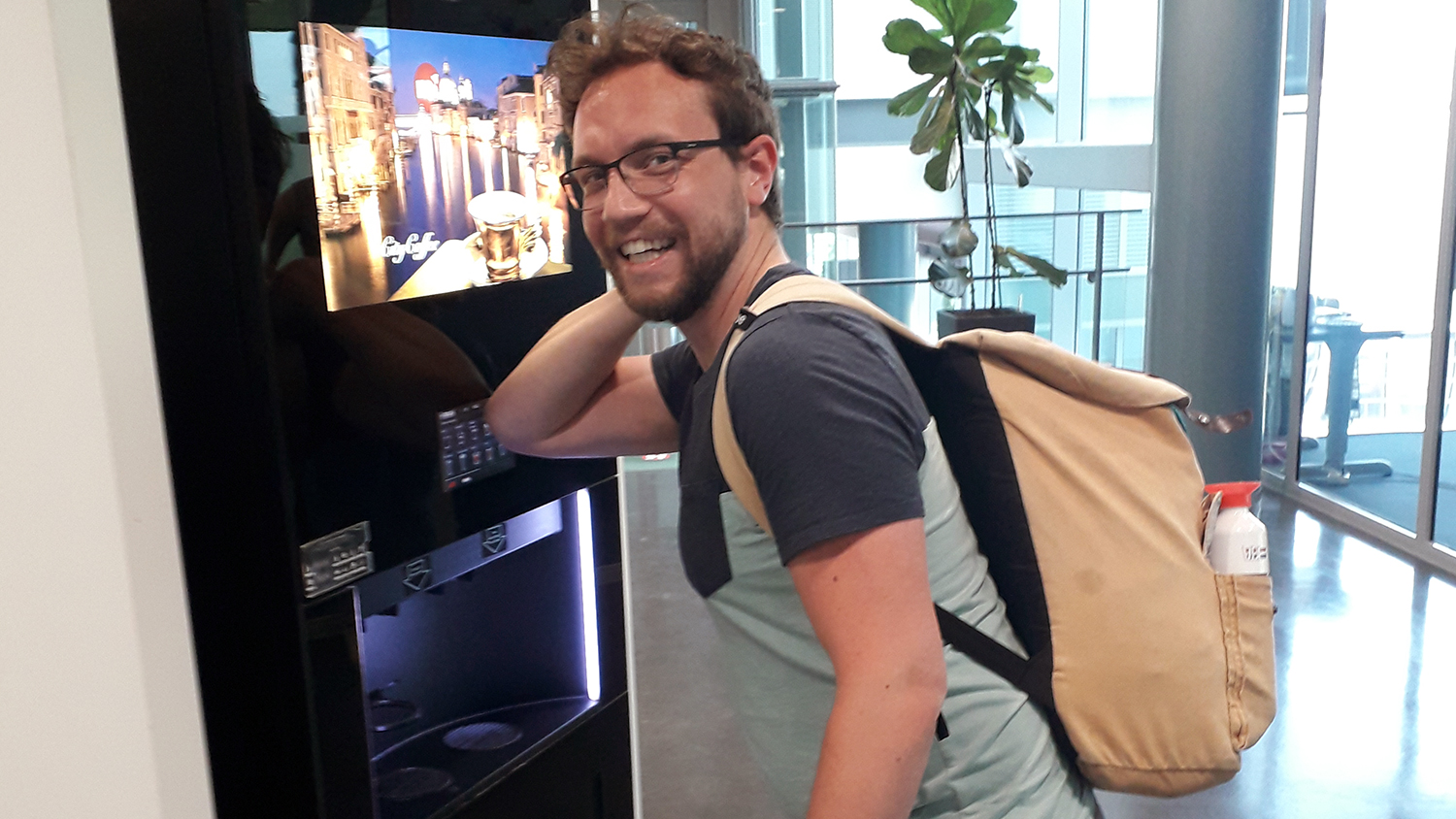Labs reopen: smaller capacity and one-way traffic in the hallways

“I was there for a bit this morning to deliver some ‘welcome back’ cookies, and I had to laugh at seeing the excess of large, yellow stickers.” This Monday, biologist and president of the faculty council Mike Boxem states his satisfaction with the adaptations to the Kruyt building that make working in the laboratories possible again.
Clean your hands at the disinfection station, sign in at the reception desk, grab a stylus pen with a rubber tip to operate lifts and coffee machines, and then walk to your desk by following the one-way route that’s indicated by a path of stickers. For now, this is the new normal for UU researchers and lab employees.
Creating plans
This past Monday, the labs in seven buildings of the Faculty of Science were reopened; on Tuesday and Wednesday, the research facilities of Veterinary Medicine and Geosciences followed. The experimental researchers are the first UU employees who are welcomed back to the university buildings. Hopefully, practicum education will follow soon. Other students and employees will have to wait a little longer.
At the faculty of Science, nearly all the groups that depend on laboratory facilities were able to get back to work on Monday – albeit under strict conditions. All buildings could only have a maximum of 30 percent occupation. To achieve this, the groups had to create plans for a new way of working in which only a minority of employees could work simultaneously. Those proposals then had to be approved by the faculty board.
Coffee machines
The reopening of the buildings was preceded by weeks of thorough preparations, says Eddie Verzendaal, director of the Facilities Service Centre. They didn’t just think about safely using lab equipment and scaling up the cleaning services, manning the reception desk, and the use of coffee machines. The buildings also had to meet numerous criteria established by Verzendaal and the university workgroup ‘Operations’.

This workgroup, which he’s chairman of, studies the consequences the ‘1.5-metre society’ will have for the university, and decided on the maximum of 30 percent occupation of workplaces in a building, among other things. They also provided a checklist for each building. “The checklist includes things like spreading the employees that enter or leave throughout the building, that we create one-way walking routes in each building, that there’s a maximum of occupants per space, and that employees don’t share workplaces or computers.”
Urinals
In the past few weeks, Verzendaal could feel the pressure from researchers to reopen the labs grow significantly. More and more rumours floated around that other universities were more generous and offered their researchers more options. “We took responsibility by closing the labs,” the FSC director says. “But I’m happy that we can now start to reopen everything, step by step and monitored.”
For now, the buildings are open between 8.30am and 4.30pm. The idea is that only work that really needs lab facilities is being done right now. Those who want to draw up their results will have to do so at home.
Still, research groups have already remarked that they feel the opening hours are too limited, especially now they have to work in shifts. “We’re going to see if an extension of the opening hours is possible, but one important limitation is that at any given time, there need to be enough employees present who’ve done emergency response training. That is rather tricky to achieve.”
Common sense
Late last week, all buildings were equipped with information boards. Stickers were stuck on the floors to indicate the walking routes and the maximum capacity per room, but also to clarify where employees have to line up for the lifts, and which urinals to use.

Joris Baijens, work safety and environment coordinator of the faculty of Science, personally visited the Kruyt building on Monday. He got the impression that everything went smoothly there. Spread throughout the day, 130 Science employees signed in at the reception desk. In normal times, at maximum capacity, a maximum of 800 employees work in the building at the same time.
“It wasn’t as though people were queued up in front of the doors, waiting to rush in. The building itself was rather quiet. Most employees were busy starting up their research. To ensure they comply with the 1.5-metre rule, some people have to redesign their labs. And of course, it’s a rather odd week, as the buildings will be closed again for Ascension Day on Thursday and Friday.”
Most of the Kruyt building residents seem happy with the stickers and other information, Baijens says. In the spacious Kruyt building, with two hallways per wing, the prescribed walking routes don’t cause any issues. “Some people say they’re a little annoyed that the one-way traffic means walking a little further to the coffee machine even though the building’s nearly empty. But of course we’re not going to check whether people actually follow the correct walking routes. The most important thing is that people use their common sense, we say.”
Happy as a clam
Professor of Catalysts and Energy Materials Petra de Jongh can now use six of the more than twenty labs on the fourth floor of the De Wied building. The other labs remain closed for the renovation of the building, which had already started before the corona crisis.
This week, a core team of technicians and some staff members and PhD candidates, along with building maintenance, are preparing to reopen the labs by next Monday for the PhD candidates and Postdocs. De Jongh: “In these cases, support staff are worth their weight in gold.”
She herself has already been faced with several odd surprises. “The coffee machines here, for instance, have a touch screen that responds to heat, so you have to touch them to make them work. Rubber pens don’t work. People are trying to order espressos by using their elbows.”

'New style' coffee ordering in the De Wiedgebouw. PhD candidate Luc Smulders makes an attempt. Photo by Petra de Jongh
More than fifty of the hundred or so young researchers in the Inorganic Chemistry and Catalysis group have indicated they would be scheduled for a part of the day for lab work in the coming weeks. “That was a surprisingly high number, given the limited number of labs that are available. We’ll have to see whether we can honour everyone’s wishes.”
De Jongh is “happy as a clam” that her work group can get back to work as well. She says the weeks in which the labs were closed, and for instance external clients couldn’t work either, have caused a lot of damage. She also noticed that in the outside world, there was little sympathy for the fact that the UU had closed all its labs.
But the professor sees there’s still a long way to go. “In the De Wied building, the labs are usually more than full already. If we have to work at 30 percent capacity for an extended period of time, it’ll become a huge jigsaw puzzle. Not just for the research, but for the Master’s and Bachelor’s students we teach here, too.”
Physical workBiologist Mike Boxem remarked that it wasn’t very busy yet in the Kruyt building. “We’re working with an online calendar so we can stick to the maximum number of employees present, but I think we weren’t at maximum capacity yet.” From other groups, he’s heard that more employees want to get back to work than is allowed.
Boxem is happy, at any rate, that the labs are open again. He shares the sentiment of a colleague who remarked how nice it was to be ‘physically’ working again. “But I do miss contact with the group a lot, and live meetings won’t happen anytime soon.”